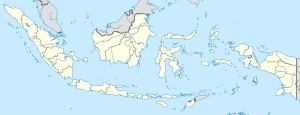Wainyapu, Sumba
Wainyapu | |
|---|---|
 | |
Location in Indonesia | |
| Coordinates: 9°37′52″S 119°00′28″E / 9.630983504°S 119.00785583°E | |
| Country | Indonesia |
| Region | Lesser Sunda Islands |
| Province | East Nusa Tenggara |
| Regency | Sumba Barat Daya |
| Time zone | UTC+8 (WITA / UTC) |
Waiyapu is a traditional village (desa) on Sumba island, East Nusa Tenggara province, Indonesia.
It has some 1,400 dolmens - one of the highest concentrations of these megaliths on Sumba.
Location
[edit]Waiyapu is on the south-west coast of Sumba, about 8 kilometers (5.0 mi) from the western tip of the island and 200 kilometers (120 mi) west of Waingapu. It stands on the south side of the estuary of the Luku Lambatama river.[1][2] The traditional village of Ratenggaro is within sight, just on the other side of the river.[3]
Administratively, it is a village (desa) in Kodi Balaghar district, in Southwest Sumba Regency (Sumba Barat Daya).[4]
Dolmens
[edit]Wainyapu, a Kodi[a] village, has some 1,400 dolmens — one of the highest concentrations on Sumba.[6] This island is the last place on Earth where some cultures still follow the traditions of the hill tribes of South-East Asia and commonly build megaliths such as dolmens for collective graves.[7] About 100 megalithic tombs are still built each year (as of 2021). These tombs are more frequent in the west part of Sumba,[6] inhabited by segmentary societies made of clans and of politically autonomous villages.[8]
Wainyapu follows the typical set-up where the dolmens are mainly within the village, many of them in front of the lineage's main house. Some dolmens are also outside the village in the fields or near the pastures.[6]
Wainyapu owns a lime quarry that provides the huge slabs needed for the dolmens. In 2008, Anakalang prince Umbu Dingu ordered a 16-tons stone to cover the tomb of his father Reda Ana Buni. This stone slab was manually pulled by about 400 men from the quarry to the village on tree trunk rollers. The complete process of negociations, extraction, paring, transport over some 5 kilometers (3.1 mi) and animal sacrifices, required some 4,000 personnes and took two years to achieve.[9]
Notes
[edit]References
[edit]- ^ "Wainyapu, satellite view". google.com/maps.
- ^ "High-resolution map of West Sumba with contour lines". maps.lib.utexas.edu (made by the US Army Map service). Retrieved 2024-06-15.
- ^ "Wainyapu". voyage.alpviv.org (in French). Retrieved 2024-06-16.
- ^ "Waiyapu". nomor.net. Retrieved 2024-06-16.
- ^ Jeunesse et al. 2021, § 4.
- ^ a b c Jeunesse, Christian; Bec-Drelon, Noisette; Boulestin, Bruno; Denaire, Anthony (2021). "Aspects de la gestion des dolmens et des tombes collectives actuels dans les sociétés de l'île de Sumba (Indonésie)" [Ethnoarchaeology of funeral practices: aspects of the management of current dolmens and collective tombs in the tribal societies of Sumba Island (Indonesia)]. Préhistoires méditerranéennes (in French). 9 (2): 165-179 (see § 8). Retrieved 2024-06-15.
- ^ Jeunesse et al. 2021, § 3.
- ^ Jeunesse et al. 2021, § 6.
- ^ "Des dolmens « modernes » en Indonésie : le déplacement des dalles à Wainyapu". unige.ch (exhibition "Megaliths here and elsewhere"; includes a short video showing a large team of people pulling along a huge limestone slab to build a dolmen) (in French). University of Geneva. Retrieved 2024-06-16.


